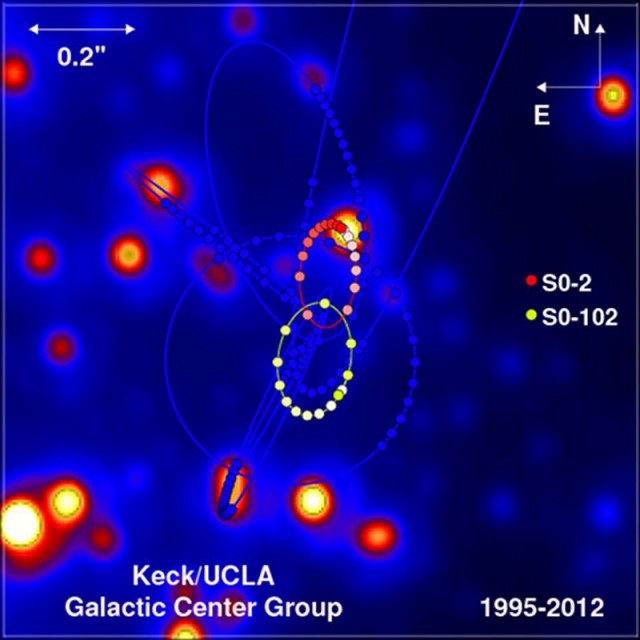Motion of stars could provide new test regime for general relativity.

Reconstruction of the orbits of two stars—S0-2 and S0-102—near the black hole at the Milky Way's center. (Other stars' orbits are also depicted by fainter lines.) The background is a real high-resolution infrared image of the region.
The Keck team, led by UCLA astronomer Andrea Ghez, has now identified a star that orbits the black hole in 11.5 years, the shortest orbital period for a star yet discovered. Thanks to this relatively quick motion, the astronomers have completely mapped the orbit of this star, known as S0-102, making it the second such star observed. Knowledge of complete orbits helps with modeling the black hole itself, which is invisible in IR light. While the data so far doesn't deviate from Newtonian gravity, observations over multiple orbits should allow for tests of general relativity in the region close to a black hole—something that hasn't been done yet using stellar orbits.
Since 1995, researchers have mapped the motions of stars around the central black hole, using high-resolution IR images. At Keck, such imaging was facilitated by adaptive optics, wherein the shape of the 10-meter-diameter mirror was adjusted dynamically to correct for atmospheric distortion. With such techniques, astronomers were able to pinpoint the location and paths of a significant number of stars near the black hole, known as theS-stars.
One of the earliest identified S-stars was S0-2, with an orbital period of about 16 years. Until the discovery of S0-102, it was the only star with a sufficiently short orbital period to enable a complete three-dimensional reconstruction of its trajectory, which provided the best data on the shape of the black hole's gravitational influence.
The reason S0-102 evaded discovery is that it is faint—S0-2 is 16 times brighter. Because of its faintness, observations have suffered from "source confusion," where light from multiple objects mingles, affecting the appearance of the star. As a result, the astronomers used the black hole data from prior observations to determine S0-102's orbital properties, rather than using the star as a way to study the black hole itself.

However, with the orbit better understood, the ultimate goal is to use the motion of SO-102 and other stars to map the "gravitational potential," the three-dimensional picture of the black hole's gravitational field. Currently, the stars' motion can be modeled using Newtonian physics and Kepler's laws to a high degree of accuracy, but a more detailed analysis should reveal deviations from Newtonian motion. This provides a test of general relativity in a new regime, where gravity is much stronger than in the Solar System (and even in binary pulsar systems, which provide some of the best strong-gravity tests right now).
General relativistic effects are cumulative over multiple orbits, however, so 17 years isn't sufficient time to begin seeing them for stars with 11.5 and 16 year orbital periods. Such effects include precession, where the orbit traces a Spirograph pattern rather than a closed ellipse; and redshifting, where the black hole's gravitational influence stretches the wavelength of light from the stars. Both of these are small effects, so longer observations will be required to see them.
These new results are complementary to observations of gas jets near the supermassive black hole in M87. The motion of stars doesn't bring us as close to the black hole's event horizon, but the data is much cleaner, since there are forces other than gravity (like magnetic fields) at play near the black hole, and these make modeling very complicated. But at the distances these stars orbit, the black hole's gravity is far and away the most significant influence. Observations of stars like S0-102 provide direct data about the gravitation of the black hole.
No comments:
Post a Comment